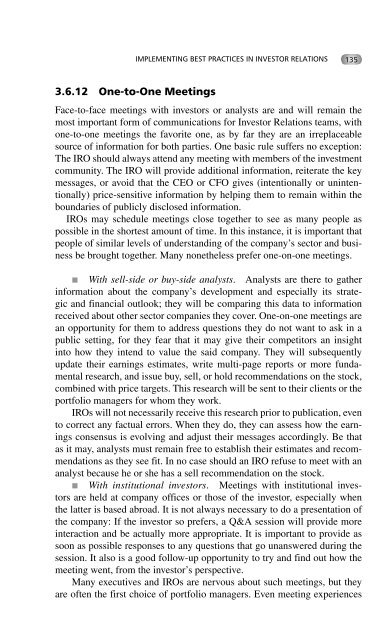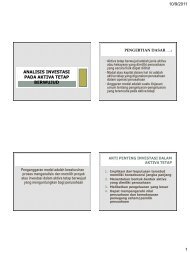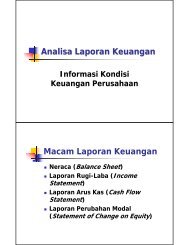Investor Relations
Investor Relations
Investor Relations
- No tags were found...
You also want an ePaper? Increase the reach of your titles
YUMPU automatically turns print PDFs into web optimized ePapers that Google loves.
IMPLEMENTING BEST PRACTICES IN INVESTOR RELATIONS 1353.6.12 One-to-One MeetingsFace-to-face meetings with investors or analysts are and will remain themost important form of communications for <strong>Investor</strong> <strong>Relations</strong> teams, withone-to-one meetings the favorite one, as by far they are an irreplaceablesource of information for both parties. One basic rule suffers no exception:The IRO should always attend any meeting with members of the investmentcommunity. The IRO will provide additional information, reiterate the keymessages, or avoid that the CEO or CFO gives (intentionally or unintentionally)price-sensitive information by helping them to remain within theboundaries of publicly disclosed information.IROs may schedule meetings close together to see as many people aspossible in the shortest amount of time. In this instance, it is important thatpeople of similar levels of understanding of the company’s sector and businessbe brought together. Many nonetheless prefer one-on-one meetings. With sell-side or buy-side analysts. Analysts are there to gatherinformation about the company’s development and especially its strategicand financial outlook; they will be comparing this data to informationreceived about other sector companies they cover. One-on-one meetings arean opportunity for them to address questions they do not want to ask in apublic setting, for they fear that it may give their competitors an insightinto how they intend to value the said company. They will subsequentlyupdate their earnings estimates, write multi-page reports or more fundamentalresearch, and issue buy, sell, or hold recommendations on the stock,combined with price targets. This research will be sent to their clients or theportfolio managers for whom they work.IROs will not necessarily receive this research prior to publication, evento correct any factual errors. When they do, they can assess how the earningsconsensus is evolving and adjust their messages accordingly. Be thatas it may, analysts must remain free to establish their estimates and recommendationsas they see fit. In no case should an IRO refuse to meet with ananalyst because he or she has a sell recommendation on the stock. With institutional investors. Meetings with institutional investorsare held at company offices or those of the investor, especially whenthe latter is based abroad. It is not always necessary to do a presentation ofthe company: If the investor so prefers, a Q&A session will provide moreinteraction and be actually more appropriate. It is important to provide assoon as possible responses to any questions that go unanswered during thesession. It also is a good follow-up opportunity to try and find out how themeeting went, from the investor’s perspective.Many executives and IROs are nervous about such meetings, but theyare often the first choice of portfolio managers. Even meeting experiences











